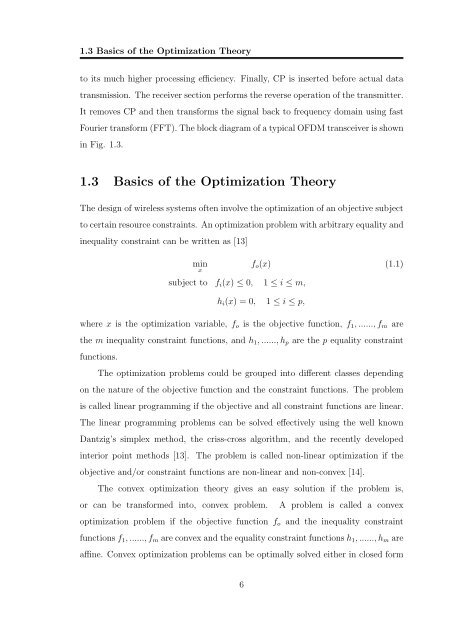Resource Allocation in OFDM Based Wireless Relay Networks ...
Resource Allocation in OFDM Based Wireless Relay Networks ...
Resource Allocation in OFDM Based Wireless Relay Networks ...
You also want an ePaper? Increase the reach of your titles
YUMPU automatically turns print PDFs into web optimized ePapers that Google loves.
1.3 Basics of the Optimization Theory<br />
to its much higher process<strong>in</strong>g efficiency. F<strong>in</strong>ally, CP is <strong>in</strong>serted before actual data<br />
transmission. The receiver section performs the reverse operation of the transmitter.<br />
It removes CP and then transforms the signal back to frequency doma<strong>in</strong> us<strong>in</strong>g fast<br />
Fourier transform (FFT). The block diagram of a typical <strong>OFDM</strong> transceiver is shown<br />
<strong>in</strong> Fig. 1.3.<br />
1.3 Basics of the Optimization Theory<br />
The design of wireless systems often <strong>in</strong>volve the optimization of an objective subject<br />
to certa<strong>in</strong> resource constra<strong>in</strong>ts. An optimization problem with arbitrary equality and<br />
<strong>in</strong>equality constra<strong>in</strong>t can be written as [13]<br />
m<strong>in</strong><br />
x<br />
f o (x) (1.1)<br />
subject to f i (x) ≤ 0, 1 ≤ i ≤ m,<br />
h i (x) = 0, 1 ≤ i ≤ p,<br />
where x is the optimization variable, f o is the objective function, f 1 , ......, f m are<br />
the m <strong>in</strong>equality constra<strong>in</strong>t functions, and h 1 , ......, h p are the p equality constra<strong>in</strong>t<br />
functions.<br />
The optimization problems could be grouped <strong>in</strong>to different classes depend<strong>in</strong>g<br />
on the nature of the objective function and the constra<strong>in</strong>t functions. The problem<br />
is called l<strong>in</strong>ear programm<strong>in</strong>g if the objective and all constra<strong>in</strong>t functions are l<strong>in</strong>ear.<br />
The l<strong>in</strong>ear programm<strong>in</strong>g problems can be solved effectively us<strong>in</strong>g the well known<br />
Dantzig’s simplex method, the criss-cross algorithm, and the recently developed<br />
<strong>in</strong>terior po<strong>in</strong>t methods [13]. The problem is called non-l<strong>in</strong>ear optimization if the<br />
objective and/or constra<strong>in</strong>t functions are non-l<strong>in</strong>ear and non-convex [14].<br />
The convex optimization theory gives an easy solution if the problem is,<br />
or can be transformed <strong>in</strong>to, convex problem.<br />
optimization problem if the objective function f o<br />
A problem is called a convex<br />
and the <strong>in</strong>equality constra<strong>in</strong>t<br />
functions f 1 , ......, f m are convex and the equality constra<strong>in</strong>t functions h 1 , ......, h m are<br />
aff<strong>in</strong>e. Convex optimization problems can be optimally solved either <strong>in</strong> closed form<br />
6

















